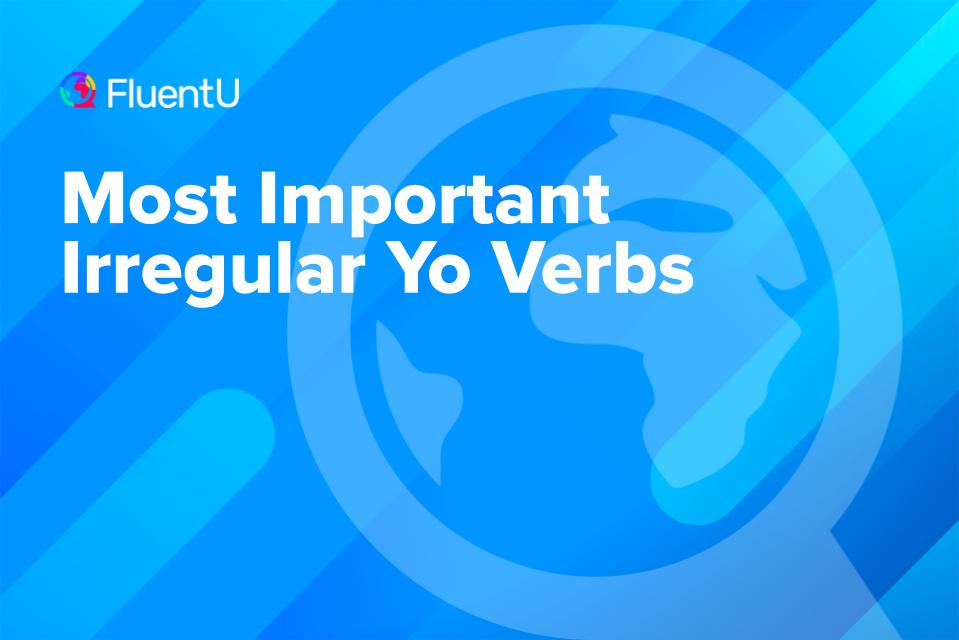Most Important Irregular Yo Verbs

The Spanish yo form is what you need to talk about yourself, so it’s a pretty critical part of learning the language.
Spanish just seems to heap on the irregularities in this form, but this guide will clear it up for you! Learn about common verbs with irregular present tense yo forms and how exactly to conjugate them.
Download: This blog post is available as a convenient and portable PDF that you can take anywhere. Click here to get a copy. (Download)
How to Conjugate the Regular Yo Forms of Spanish Verbs
The yo form is the first-person singular in Spanish, and this key verb conjugation is used to make the Spanish versions of our English “I” statements.
Just to refresh your memory, the regular yo conjugation for –ar, –er and –ir verbs is all the same; take off that infinitive ending and add an –o. For example:
- Bailar → Bail- → Bailo (I dance)
- Comer → Com- → Como (I eat)
- Vivir → Viv- → Vivo (I live)
If only Spanish were always that easy, huh?
Irregular Yo Forms in Spanish
Forms Ending in -go
There’s quite a number of common and useful verbs that have yo forms ending in -go.
Watch out! Some of them experience changes in the stem of the verb as well.
- Salir → Salgo (I go out)
- Tener → Tengo (I have)
- Hacer → Hago (I do/make)
- Poner → Pongo (I put)
- Caer → Caigo (I fall)
- Traer → Traigo (I bring)
- Venir → Vengo (I come)
Here are some examples of these verbs in use:
Pongo la mesa. (I set the table.)
Salgo con ella. (I go out with her.)
Hago desayuno todos los días. (I make breakfast every day.)
Forms Ending in -oy
These incredibly useful verbs have yo forms ending in –oy.
- Ser → Soy (I am [permanent characteristic])
- Estar → Estoy (I am [in a location or a temporary state])
- Dar → Doy (I give)
See here if you need to review the difference between ser and estar. Let’s look at some sentence examples:
Soy estadounidense. (I’m American.)
Estoy feliz. (I’m happy.)
Te doy un regalo. (I’m giving you a present.)
If you’re looking back at the present tense yo forms to prepare for the subjunctive, note that these three verbs don’t follow the normal subjunctive pattern.
Bu these are some of the most common Spanish verbs around, so it’s important to get their conjugation right.
To internalize them better you could practice with FluentU’s Spanish video clips, which come with interactive subtitles and other study tools.
FluentU takes authentic videos—like music videos, movie trailers, news and inspiring talks—and turns them into personalized language learning lessons.
You can try FluentU for free for 2 weeks. Check out the website or download the iOS app or Android app.
P.S. If you decide to sign up now, you can take advantage of our current sale!

There’s also the FluentU Spanish YouTube channel where you can find in-depth video lessons that use Spanish-dubbed episodes of popular TV shows and movies to teach Spanish vocabulary and grammar.
Forms Ending in -zco
Generally, verbs whose infinitives end in a vowel followed by –cer or –cir will then have yo forms that end in –zco.
Two exceptions to this are the verbs hacer and decir, which both have –go endings for their yo forms, as we saw above.
Here are some of the most common verbs that you’ll encounter with such a change:
- Agradecer → Agradezco (I thank/appreciate)
- Conducir → Conduzco (I drive/lead)
- Conocer → Conozco (I know [e.g., a person])
- Crecer → Crezco (I grow)
- Introducir → Introduzco (I introduce)
- Merecer → Merezco (I deserve)
- Nacer → Nazco (I am born)
- Ofrecer → Ofrezco (I offer)
- Permanecer → Permanezco (I remain)
- Producir → Produzco (I produce)
- Traducir → Traduzco (I translate)
We can form some basic sentences with these:
No conozco a nadie en esta fiesta. (I don’t know anyone at this party.)
Merezco un premio. (I deserve a prize.)
Traduzco toda la mañana. (I translate all morning.)
Important Verbs: Ver and Saber
There are two incredibly important verbs that are regular in all of their present tense conjugations except for yo: ver (to see) and saber (to know).
- Ver → Veo (I see)
- Saber → Sé (I know)
Note that the word sé isn’t used as a sentence all by itself. You can instead say:
Yo sé. (I know.)
Lo sé. (I know it.)
No sé. (I don’t know.)
And veo can be used in all kinds of ways:
Veo. (I see.)
Veo a un amigo allí. (I see a friend there.)
Te veo mal. (You don’t look well. Literally: “I see you badly.”)
Verbs Ending in -guir, -ger and -gir
The rules that you’ve probably already learned for spelling changes in Spanish are particularly useful for making the yo forms of verbs:
- If g is followed by e or i, it has an aspirated sound, like an English h.
- If g is followed by a different vowel, it sounds like our English “g” in “go.”
Let’s take the example of proteger (to protect), which has a Spanish g sound that’s pronounced like the English letter “h,” as in “hair.” If we were to change the ending to an o to make our yo form, we would get: protego
But that’s not correct! According to spelling rules, this would be pronounced with a hard g sound, due to the syllable go.
We don’t want to create that hard g sound out of nowhere! So instead, to preserve our h pronunciation, we change the spelling and use a j, which in Spanish usually makes that same h sound that we want: protejo (I protect).
Here’s a list of common verbs that work this way (some, you’ll notice, also have stem changes):
- Coger → Cojo (I catch) (Be aware that in many Latin American countries this is also a strong curse word)
- Corregir → Corrijo (I correct)
- Dirigir → Dirijo (I direct)
- Elegir → Elijo (I elect)
- Exigir → Exijo (I demand)
- Fingir → Finjo (I pretend)
- Proteger → Protejo (I protect)
- Surgir → Surjo (I spring forth/emerge/appear)
The opposite phenomenon occurs when you have infinitives ending in –guir. Recall that the u here isn’t pronounced and is just serving to give us a hard g sound. We want to conserve that hard g sound, so we no longer need the u when we make our yo conjugation.
Take another very common example, seguir (to follow), which is pronounced with a hard g as in “go.” If we just dropped the –ir ending and slapped on an o to make the yo form, we’d lose that hard g sound.
To maintain it, we remove the u after the g in our yo form (you’ll notice that there is, unrelatedly, a stem change in the second letter): sigo (I follow)
Here are the examples of this phenomenon:
- Distinguir → Distingo (I distinguish)
- Extinguir → Extingo (I extinguish)
- Seguir → Sigo (I follow)
Let’s see a few of the verbs from this section in sentences:
Te sigo. (I’m following you.)
Dirijo una peli. (I’m directing a film.)
Protejo la planeta. (I protect the planet.)
Prefixes and Irregular Spanish Yo Forms
Once you’ve got all of those conjugations down, I’ve got some fantastic news for you: You can apply the above yo conjugations in exactly the same way to the alternate, prefixed forms of those verbs.
For example:
- Conseguir (to succeed) follows the same pattern as seguir and becomes consigo (I succeed) in the yo form.
- Reconocer works just like conocer and becomes reconozco (I recognize) in the yo form.
- Atraer (to attract) functions like traer and becomes atraigo (I attract) in the yo form.
When you encounter new verbs that are composed of the verbs above plus a prefix, you can rest assured that you already know how they’re conjugated for the yo form.
Why Learn Spanish Verbs with Irregular Yo Forms?
We have to learn irregular yo forms well because we use the first-person present tense an awful lot during casual and formal conversations.
Knowing irregular present tense yo forms is also necessary when studying the present-tense subjunctive (for talking about hypothetical or desired actions). So if we don’t get these present tense yo conjugations down pat, they’ll come back to haunt us!
That’s quite a lot of grammatical territory to cover, but fortunately, these conjugations are also easy to practice. Just write and talk about yourself!
What common actions are you taking now? What things do you generally do? Whom do you protect, what do you see and what or whom do you know?
Answering those questions in Spanish will undoubtedly already have you using your irregular yo conjugations.
Download: This blog post is available as a convenient and portable PDF that you can take anywhere. Click here to get a copy. (Download)
And One More Thing…
If you've made it this far that means you probably enjoy learning Spanish with engaging material and will then love FluentU.
Other sites use scripted content. FluentU uses a natural approach that helps you ease into the Spanish language and culture over time. You’ll learn Spanish as it’s actually spoken by real people.
FluentU has a wide variety of videos, as you can see here:

FluentU brings native videos within reach with interactive transcripts. You can tap on any word to look it up instantly. Every definition has examples that have been written to help you understand how the word is used. If you see an interesting word you don’t know, you can add it to a vocab list.

Review a complete interactive transcript under the Dialogue tab, and find words and phrases listed under Vocab.

Learn all the vocabulary in any video with FluentU’s robust learning engine. Swipe left or right to see more examples of the word you’re on.

The best part is that FluentU keeps track of the vocabulary that you’re learning, and gives you extra practice with difficult words. It'll even remind you when it’s time to review what you’ve learned. Every learner has a truly personalized experience, even if they’re learning with the same video.
Start using the FluentU website on your computer or tablet or, better yet, download the FluentU app from the iTunes or Google Play store. Click here to take advantage of our current sale! (Expires at the end of this month.)







